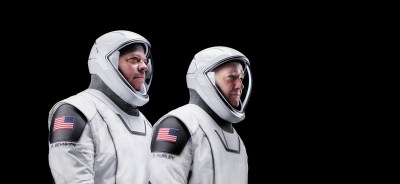We keep finding more great space stories than we can cover, so here’s a speed-run through the broader picture of the moment as it applies to space flight.
The big news this week was the first launch of a manned SpaceX Crew Dragon capsule to the ISS. I was excited because the pass en route to the space station was scheduled to be visible from the UK at dusk, and on Wednesday evening I perched atop a nearby hill staring intently at the horizon. Except it had been cancelled due to bad weather. The next launch window is planned for today and you can watch it live.
 Meanwhile, fashion is the other piece of this manned-launch’s appeal. Their sharply-designed spacesuits have attracted a lot of attention, moving on from the bulky functional Michelin Man aesthetic of previous NASA and Roscosmos garments for a positively futuristic look that wouldn’t be out of place in Star Trek. Never mind that the two astronauts are more seasoned space dog than catwalk model, they still look pretty cool to us. Against the backdrop of a political upheaval at the top of NASA, this first crewed orbital mission from American soil since the retirement of the Shuttle has assumed an importance much greater than might be expected from a run-of-the-mill spaceflight.
Meanwhile, fashion is the other piece of this manned-launch’s appeal. Their sharply-designed spacesuits have attracted a lot of attention, moving on from the bulky functional Michelin Man aesthetic of previous NASA and Roscosmos garments for a positively futuristic look that wouldn’t be out of place in Star Trek. Never mind that the two astronauts are more seasoned space dog than catwalk model, they still look pretty cool to us. Against the backdrop of a political upheaval at the top of NASA, this first crewed orbital mission from American soil since the retirement of the Shuttle has assumed an importance much greater than might be expected from a run-of-the-mill spaceflight.
While we’re on the subject of the ISS, it’s worth noting that we’re approaching twenty years since the first crew took up residence there, and it has been continuously crewed ever since as an off-planet outpost. This is an astounding achievement for all the engineers, scientists, and crews involved, and though space launches perhaps don’t have the magic they had five decades ago it’s still an awe-inspiring sight to see a man-made object big enough to discern its shape pass over in the night sky. We understand that current plans are to retain the station until at least 2030, so it’s a sight that should remain with us for a while longer.
 Closer to Earth are a couple of tests for relative newcomers to the skies. When Richard Branson’s Virgin group isn’t trying to boot millionaires off the planet through its Virgin Galactic operation, it’s aiming to cheaply fling small satellites into orbit from a rocket-toting airborne Boeing 747 with its Virgin Orbit subsidiary. Their first test launch sadly didn’t make it to space, once the rocket had flawlessly launched from the airliner it suffered a fault and the mission had to be aborted. Getting into space is hard.
Closer to Earth are a couple of tests for relative newcomers to the skies. When Richard Branson’s Virgin group isn’t trying to boot millionaires off the planet through its Virgin Galactic operation, it’s aiming to cheaply fling small satellites into orbit from a rocket-toting airborne Boeing 747 with its Virgin Orbit subsidiary. Their first test launch sadly didn’t make it to space, once the rocket had flawlessly launched from the airliner it suffered a fault and the mission had to be aborted. Getting into space is hard.
The second test was never intended to make it into space, but is no less noteworthy. The British company Skyrora have performed a successful ground test of their Skylark L rocket, aiming for a first launch next year and for offering low-earth orbit services by 2023. This is significant because it will be the first British launch since the ill-fated Black Arrow launch in 1971, and with their Scottish launch site the first ever from British soil. If you’ve seen Skyrora mentioned here before, it is because they were behind the retrieval of the Black Arrow wreckage from the Aussie outback that we mentioned when we wrote about that programme.
Looking forward to the coming week, especially today’s rescheduled SpaceX launch. This time however, I’ll check the weather conditions before climbing any hills.















SpaceX managed to perform a RUD on one of their Starship prototypes on Friday, too. It’s business as usual for their rapid development process, but made an impressive boom.
Per this Scott Manley analysis, it appears that the catastrophic failure of the Space-X Starship booster prototype happened after the static test completed. Apparently, a liquid methane line broke during defueling, spewing its contents all around the prototype, just waiting for an ignition source. Regardless, it was a spectacle.
Good analysis and video here.
https://www.youtube.com/watch?v=BCUYG5SonCY
The tagline on Scott Manley’s YouTube page summarizes the situation perfectly:
“It was going well until it exploded.”
My father, who was involved in a number of launch vehicles in the 1960s and 1970s, summarized it as:
“If at first you don’t succeed, then you’re probably trying to launch a rocket.”
Escape velocity is still ~25k mph is Branson leaving or just doing a ‘peek’? 747 max V is ~600mph. Can’t confuse height with orbit
Ah, can achieve 310 mile orbit, ~15k-18k mph, 660lb payload. Cubesats etc.
Ars Technica has had great coverage of spaceflight for a while, but I haven’t seen a piece in those neat flight pajamas. How do they compare to NASA’s pumpkin suits? Are they really sleeker?
Just shows how far we’ve come since those first shuttle launches, we can now identify Astronauts from DNA extracted from a few spots of fluid soaked into terrycloth, rather than having to rely on an armored glove protecting a finger tip for the prints, to identify them after the crash.
“Getting into space is hard.”
Which is a good thing.
Well it would be nice if it was a little easier, you can’t stay in the cradle forever.
This is funny (xkcd), but also part of our day-one training for new employees at my company: https://www.youtube.com/watch?v=2p_8gx-XHJo
All good. Dragon in orbit, one orbital burn down. So far so good! 1st stage landed successfully. Cool stuff.
Are these compact space suits good for EVA or just precaution in case there’s some minor problem with cabin?
They’re only for cabin depressurisation. They rely on umbilical connections to the seats, but they should allow for the crew to work in a completely depressurised vessel.
In the early 90’s I made some stuff that was supposed to measure the temperature underneath the new flexible heat shield of the space shuttle. You probably remember those damn tiles falling off due to vibrations.
Yesterday I got sent a link to a tweet:
https://twitter.com/Barnz_N_Noblez/status/1266887698406617093?s=20
Which appears to show a very brave and sturdy rodent hitching a ride on Elon’s rocket…
This was not the first time I saw something that made me go: erm…
There’s not enough detail to verify that this is a rodent, and not just some ice or condensation.
Am I the only one who sees so much money and effort wasted on a dream that won’t bring us further than mars for thousands of years.
A dead rock with no returns.
An arrogant and useless venture other than to sell a dream.
It even makes it easier for the masses to ignore the real situation down here. That we’re killing earth. We can go to Mars right if all goes wrong.
Right?
What will this bring us humans now that ai won’t be able to construct in the future once we have a technology that solved our mortality
..
Why send humans if all we seek is knowledge for now??
The biggest danger to human survival on Earth is other people. Going to Mars is not going to fix that.
Skyrora’s website breaks GPDR rules by forcing you to accept their cookie policy with no apparent option to turn cookies off.
https://www.skyrora.com/
Nobody cares.